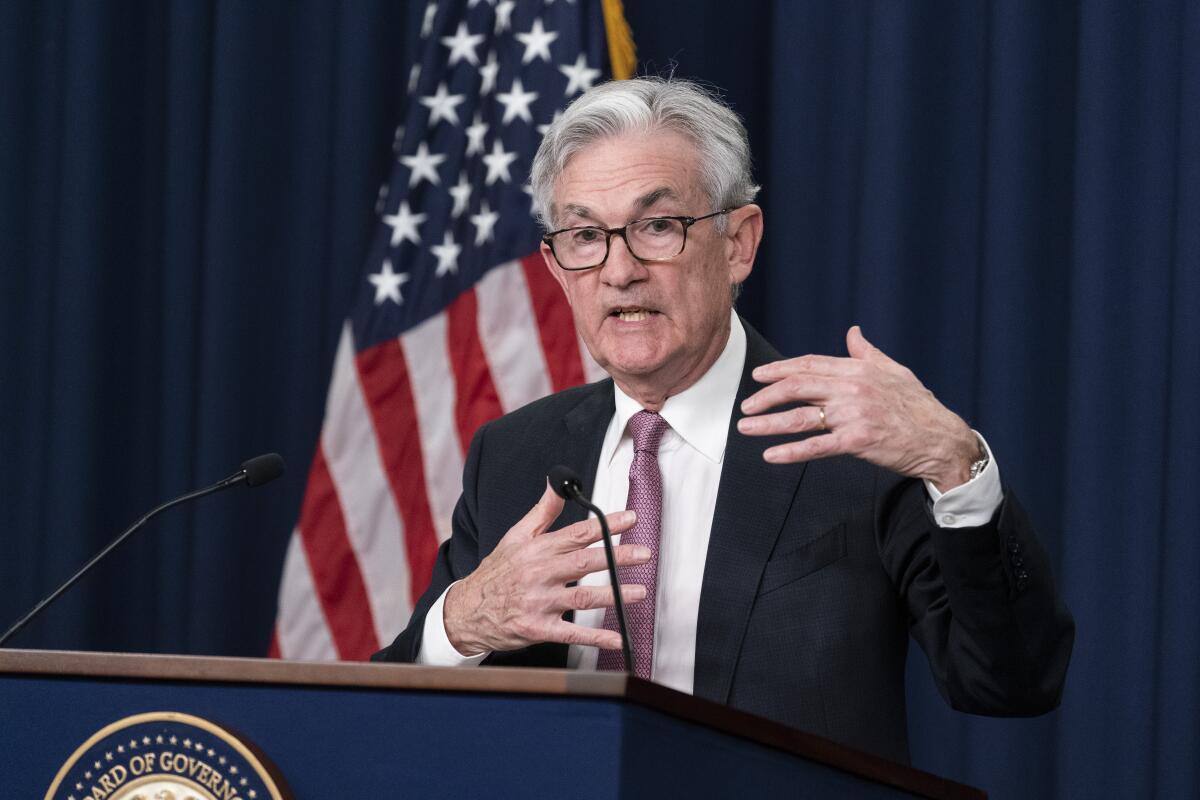Inflation eases in May, but major relief on interest rates not coming soon

- Share via
WASHINGTON — The rate of inflation eased slightly last month, the government said Wednesday, but the financial squeeze that Americans are feeling is not likely to let up anytime soon, especially in high-cost California.
That’s because a residue of sharply higher prices left behind by the COVID-19 pandemic still weighs on the pocketbooks and psychology of consumers.
Prices of new and used cars and trucks, for example, are 27% higher than before the pandemic, even though they went down 3.4% in May from a year earlier, according to the report from the Bureau of Labor Statistics. Much the same is true of other consumer goods and services, including dining out and personal care services such as hair salons as well as housing.
And there won’t be much relief on interest rates in the near term. The Federal Reserve has raised interest rates to the highest level in more than two decades to fight inflation, and on Wednesday policymakers said the fight wasn’t over.
Despite previous expectations of multiple rate cuts this year, fed officials projected just one quarter-point rate cut in 2024 in its benchmark interest rate, which currently is in the range of 5.25% to 5.5%.
The Fed, in its statement, said the economy was growing at a “solid pace,” with strong job gains and low unemployment. And Chairman Jerome H. Powell nodded to Wednesday’s better-than-expected inflation numbers.
“We do see today’s report as progress and as building confidence,” he said at a news conference. “But we don’t see ourselves as having the confidence that would warrant beginning to loosen [monetary] policy at this time.”
According to inflation data released Wednesday, overall consumer prices were up 3.3% in May from a year earlier. That’s down slightly from an annual inflation rate of 3.4% in April but still well above the Fed’s 2% target.
“We still need several more months of this, but the fundamentals are encouraging,” said Paul Ashworth, chief North America economist at Capital Economics, a research firm.
Other experts were less sanguine about the near-term inflation outlook: “It’s a maddening, sticky, stubborn situation,” said Dan North, senior economist at Allianz Trade, a credit insurance firm.
Both economists and political analysts have been puzzled that President Biden’s standing with the public on the economy has been languishing despite steady growth, strong job gains, and significant improvement in inflation. A big part of the answer is that people are still feeling the aftershocks of price increases in 2021 and 2022, when inflation peaked at 9.1%.
The costs of a broad range of everyday goods went up very sharply in those two years, and they’re not likely to return to pre-pandemic levels soon, if ever. The spillover effects are still playing out.
New vehicle prices, for example, went up by double-digit percent mostly in 2022, but auto insurance premiums, partly reflecting the higher car costs, started taking off last year and were up 20% in May from a year earlier.
Housing inflation, including rising rents and what are called homeowners’ equivalent rents, has been especially sticky, remaining in the range of 4.5% to 4.7% this year. That’s a particular concern in California, where the housing market has soared beyond the reach of most would-be buyers and high interest rates have only compounded the problem.
Despite broadly higher prices, analysts note that workers’ wages have been outpacing inflation, meaning that their purchasing power overall hasn’t weakened. In May, average weekly earnings were up 3.8% from a year earlier — a half point higher than inflation, according to a separate government report.
Still, most people living today have never experienced the kind of sharp, broad inflation that hit the U.S. during the pandemic.
“Even if you had a job, inflation is stressful because it forces you to think about day-to-day purchases,” said Aditya Bhave, senior U.S. economist at Bank of America Global Research.
People may not get over the inflation gloom and get used to the new price levels, he said, until they have “fully internalized the fact that their wages have also grown.”
But in large part because of the incremental gains in income and job gains, the higher costs have not stopped people from spending.
Consumer spending, which accounts for about two-thirds of U.S. economic activity, is expected to grow by a solid 2% this year.
Wednesday’s report showed that annual inflation also slowed in the Pacific coast region in May but is running above the nationwide average, at 3.7%, in part because of higher price increases for food, transportation and gas.
Housing inflation in May was 4.6% for the U.S. and 4.5% for the Pacific coast states, including Alaska and Hawaii.
Analysts are expecting inflation across the country to come down very slowly in the remaining months of the year, if at all. Prices for many goods, including appliances and new cars, dropped in the second half of last year, and inflation slowed sharply for other items and some services as well, all of which will make year-over-year comparisons more difficult to show favorable readings.
More to Read
Inside the business of entertainment
The Wide Shot brings you news, analysis and insights on everything from streaming wars to production — and what it all means for the future.
You may occasionally receive promotional content from the Los Angeles Times.











